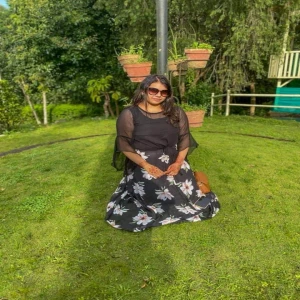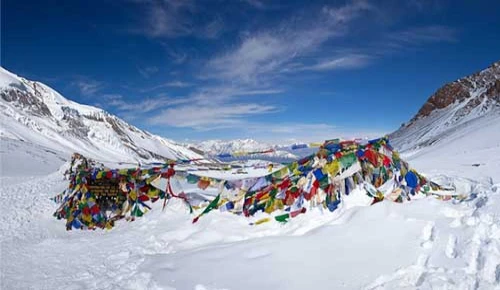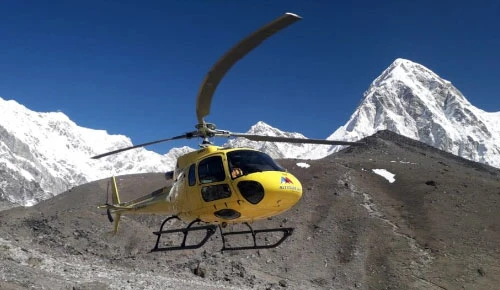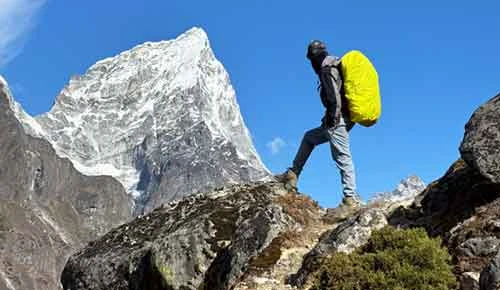Top 6 Considerations for EBC Trekking
The Everest Base Camp trek offers the sheer beauty of the Himalayas together with the ease of well-maintained routes.
Located in the heart of the majestic Himalayas, the Everest area is renowned for its breathtaking landscapes and accommodating Sherpa people. Through this trek, you will get an opportunity to learn about Nepal's customs and culture, in addition to the highest mountain in the world.
One of the most well-known treks in the world, the trek draws thousands of adventure seekers each year. This trek usually lasts 12 to 14 days and takes place in Nepal's Khumbu area. The trek is around 130 kilometers long overall, with Kala Patthar, at 5,545 meters above sea level, serving as its highest point.
Although the trek might sound thrilling and adventurous, there are still some considerations that you need to take care of before and during the trek. It is important to consider these things so you can have a fun and safe trek without any hassles.
To make your trek safe and comfortable, we have listed some factors to be taken into consideration before and during your trek.
Table of Contents
Considerations Before or During Trek
As fun as a trek to Everest Base Camp sounds, there are still some factors that need to be considered, keeping your safety and comfort in mind. Although reaching Base Camp requires a lot of trekking, the incredible views and sense of achievement make the effort worthwhile. The following things to keep in mind are:
Weather
The weather has a significant impact on both the overall experience and the safety of the trek. The best seasons of the year to go on a trek are in the spring and fall, just before and after the monsoon.
The months of March through May and September through November provide very consistent weather with bright skies and comfortable temperatures.
You should always pack by checking the weather conditions, as the temperatures can drastically drop, especially during the night. If it's sunny, you might be surprised at how warm it gets during the day. Remember to have a raincoat in your day pack, even if the weather appears to be sunny.

On the other hand, the harsh, cold winter months of December through February make climbing to higher altitudes difficult and increase the chance of snow obstructing the pathways. Heavy rainfall during the monsoon season (June to August) creates unstable and slick terrain and increases the chance of landslides.
Even though you can book during the off-seasons as well, you need to be extra careful regarding the weather conditions and take all the safety precautions needed. The trek might be difficult during the winter and monsoon seasons compared to other seasons like autumn and spring.
Temperature Ranges
At lower elevations, springtime temperatures vary from 10 to 20 degrees Celsius (50 to 68 degrees Fahrenheit). The temperature progressively drops as you rise, especially at night.
Higher elevations can see daytime temperatures of -5 to 5 degrees Celsius and nighttime lows of about -15 degrees Celsius (5 degrees Fahrenheit), like in the case of Gorak Shep, the final destination before Everest Base Camp.
Autumn is a well-liked hiking season that provides consistent weather and clear skies. At lower altitudes, daytime temperatures can range from 10 to 20 degrees Celsius (50 to 68 degrees Fahrenheit), which is comparable to springtime.
Higher elevations have nighttime temperatures of -10 degrees Celsius (14 degrees Fahrenheit) or less and daytime temperatures of 0 to 10 degrees Celsius (32 to 50 degrees Fahrenheit).
Health And Fitness
Training and physical condition are requirements if you wish to embark on this challenging trek. A strong degree of physical fitness is required for this strenuous hike because of the high altitude, steep inclines, and rough terrain. It is advised that you begin your training two months or more in advance of the planned expedition.
Make sure to have an overall health checkup done if you suffer from any illness before the trek. You also need to pay attention to your diet and hydration levels, especially during the trek. Make sure to have enough energy and protein bars in your day pack and take small breaks during your trek to munch on them.

While having lunch or dinner at tea houses and lodges, it is advised that you have carbohydrates and protein-rich foods, such as rice, lentils, and meat, to aid in muscle recovery and growth. Make sure to eat a full and proper breakfast at your lodges every day before heading out for the trek. For better digestion and to avoid altitude sickness, eat a light meal at night.
Observe hygienic standards and customs in the area. Make use of potable water that has been treated using purification tablets. Pay attention to food hygiene to prevent digestive problems. Never forget that your safety comes first. Pay attention to your body, abide by safety precautions, and be ready for the difficulties that come with hiking at high altitudes.
In case of Altitude Sickness
The most challenging obstacle during your trek is altitude sickness. Some simple preventive measures for altitude sickness are to avoid any sort of alcohol, proper hydration, energy bars, and snacks throughout the trek.
The main thing is to remember to trek slowly, as this is not a race that you’ll have to reach at a certain time. So, make sure that your body gets well adapted to each evaporation. If you feel any symptoms, take one day more at a time to acclimate.
Budget
Budget is the main factor that you’ll need to consider before booking your trip. The total cost includes several components, such as permits, lodging, food, and equipment.
If you book your Everest Base Camp trek package with us, all of the permits, lodges, and food are included in the cost. So while trekking, you can only consider the budget for your personal expenses.
Travel costs include airfare to and from Lukla, the starting point for the Everest area, as well as possible costs for further flights if severe weather affects the Lukla airfield. The price of lodging varies according to the kind selected; modest teahouses to luxurious hotels are among the options.

Meal prices vary as well; at higher elevations, the logistical difficulties of transporting cause prices to rise. The expense of equipment includes buying or renting sleeping bags, trekking poles, and insulated clothes.
Having your equipment guarantees comfort and familiarity, even though it may be rented in Kathmandu or Lukla. A budget should also account for unforeseen costs, such as emergency medical bills, should they occur.
While you’re on the trek, make sure to carry cash and not depend on ATMs too much. ATMs are only available up to Namche Bazar and even in such cases, there is only one ATM available. So it is advised for you to carry cash throughout your trek.
In general, a well-thought-out budget is necessary for an uneventful journey The amazing experience of trekking in the Himalayas is ensured by striking a balance between financial concerns and the desire for a safe and fun adventure.
Equipment and Gear
Equipment and gear are the necessities that you need to consider before your voyage. They not only help you make your trek easier but safe as well. Choosing the appropriate gear and equipment is essential to getting ready for the trek.
It's important to have a strong, well-fitting pair of hiking boots since they offer the support required for uneven terrain. Layering cozy, breathable clothes makes it easier to adjust to changing conditions, and a high-quality waterproof jacket is a must to protect against unpredictable mountain weather.

Along with that, high-SPF sunscreen and eyewear with UV protection are crucial for warding off the harsh alpine sun. Sun and cold are protected with a beanie and a cap with a broad brim. Along the way, remember to carry a water bottle and purification tablets to ensure that you have access to safe drinking water.
You can even rent certain equipment in Kathmandu or Lukla. Having your gear, especially well-worn boots and a cozy backpack makes a big difference in how much you enjoy trekking.
By creating a comprehensive plan and starting early, you can make sure you have everything you need and concentrate on the amazing scenery and many cultures seen on the base camp adventure.
Permits
Permits are a document of authorization given to you that allows you to enter the Sagarmatha National Park area. Getting the required permits is an essential part of getting ready for the trek to Everest Base Camp. The TIMS (Trekkers' Information Management System) card and the Sagarmatha National Park entry permit are the two main permits that are required.

The Everest area is included in the Sagarmatha National Park, for which entrance permits are required. The national park's entrance, Monjo, or Kathmandu are the places to get this authorization. For foreign trekkers, there is a different permit cost, which is approximately 300 USD. To fill out the permit, a valid picture ID must be carried with the permit.
An additional required document to guarantee the protection and safety of trekkers in the area is the Trekking Information Management System (TIMS) card. It contains information on the trekkers' routes and personal characteristics. The Nepal Tourism Board in Kathmandu or Pokhara, is the place to get the TIMS card.
Before starting the adventure, it's advised to confirm the most recent permit requirements and costs since they could have changed. In addition to guaranteeing adherence to regional laws, having these permits in order supports the incredible Sagarmatha National Park's conservation efforts.
Travel Insurance
Trekking requires you to adapt to the challenging weather the mountains may provide. There may be instances in which you may hurt yourself. The injuries might result from falling, spraining an arm, or experiencing altitude sickness.
Furthermore, receiving medical attention for your illnesses in the isolated highlands may require you to pay immensely high fees, even for the most basic conditions. Additionally, your travel fees may increase or even double if you have to evacuate yourself via helicopter.
Furthermore, you cannot disregard various modes in which you may experience difficulty. These include minor thefts, damage to luggage, and canceled flights. You should get travel insurance for the trek, as there are a lot of things that may go wrong on a bad day.
There may be various situations, like altitude sickness, accidents, flight cancellations, and other forms of illness, that might require your travel insurance. So, just to be on the safe side, travel insurance is highly recommended.
You will be out of your comfort zone anywhere you go when you travel abroad. There will be new acquaintances and locations you have never been to. While Nepal is a fairly secure nation for both male and female tourists, you can't always be sure that your property or health won't be harmed.
However, obtaining insurance can help you stop worrying about the security of your belongings. Getting insured and putting your troubles behind you will lead to a stress-free getaway.
Achieving Success Through Preparedness
Lastly, both physical and mental training are necessary for the expedition. Training should begin at least two months before the journey, with a focus on progressively increasing cardio and strength-training activities.
Hiking and stretching activities can help increase flexibility and endurance while lowering the chance of injury. The body can be better prepared for the trek with a healthy, balanced meal.
Researching and learning about the area, cultivating an optimistic outlook, and practicing relaxation methods are some examples of mental preparation.
You can help guarantee a safe and happy trekking adventure to Everest Base Camp by giving yourself enough time to prepare, avoiding fatigue, and placing a high priority on rest and water.








